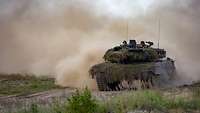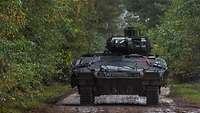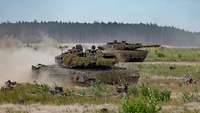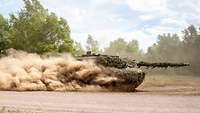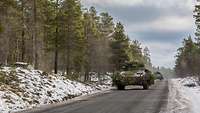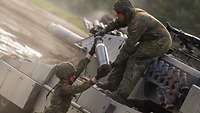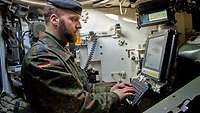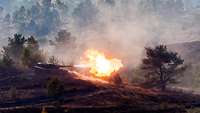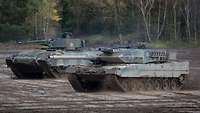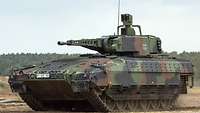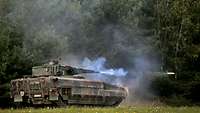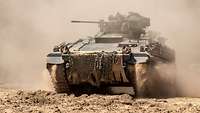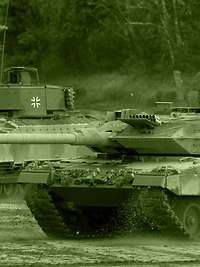
Armoured Forces
The diversity of the German Army is reflected in its arms and services, with each possessing specific capabilities and skills - but only collectively are they strong and successful. Using special equipment, they meet a wide range of requirements. Learn more about the armoured forces, one of the arms and services of the German Army.
Our mission
The armoured forces are a combined-arms service consisting of armour and armoured infantry. Their primary weapon systems are the Leopard 2 MBT and Puma IFV. The latter has, since 2015, been gradually replacing the Marder IFV still in use with the field units.
Because of the firepower, agility, striking power, protection and lethality they provide, armoured forces are particularly suited for decisive combat operations. They are capable of conducting wide-area offensive actions as well as fast, powerful attacks on close-range objectives.
Armoured forces carry out and support measures within the scope of national and collective defence as well as international conflict prevention and crisis management.
Armoured forces operate in open, partially covered and built-up terrain and support mechanised and infantry operations in different climate zones, in any weather conditions.
Being mechanised, the armoured forces are the core and backbone of the German Army and thus the mainstay of mobile land operations. They have a broad spectrum of capabilities at their disposal. They are frequently the element to bring about the decisive outcome in complex and dynamic operational environments as well as in actions taking place in parallel.
Armour
The primary task of main battle tanks is to engage enemy armoured units in open terrain. They are supported by armoured infantry and their infantry fighting vehicles, which engage enemy infantry forces.
The strength of armoured forces lies in attack, delay and defence.
Their striking power against enemy armoured forces and armoured combat support forces is particularly effective when brought to bear in gently rolling, lightly covered terrain.
Armoured infantry
Armoured infantry are highly mobile. The protection provided by their infantry fighting vehicles enables them to alternate rapidly between engaging from under armour (mounted) and fighting on foot (dismounted), thus enhancing armoured forces’ striking power. Such alternation in tactics and fighting method is employed when required by the mission, enemy situation or terrain. The principle applied in this respect is: “Mounted for as long as possible – dismounted for no longer than necessary.”
Armoured infantry fight mounted and dismounted in terrain, delivering direct and indirect fire, and also employ antitank weapons. They are deployed against enemy infantry and their armoured combat vehicles. In conjunction with the armour they sustain mobility and striking power.
Dismounted armoured infantry are particularly suited to attacking through heavily broken or overgrown terrain. Main battle tanks and infantry fighting vehicles support the dismounted forces where the terrain permits. The function of the armoured vehicles is then to give covering fire and mainly to engage enemy tanks, yet also to engage enemy forces in field fortifications.
Armoured forces of the German Army
Passen Sie jetzt Ihre Datenschutzeinstellungen an, um dieses Video zu sehen
How armoured forces fight

Panzer - Hurra (Armour - Hurrah)

Panzergrenadiere - Dran! Drauf! Drüber! (Armoured infantry - At them! On them! Over them!)
Our equipment
Leopard 2 MBT
The Leopard 2 main battle tank is the primary weapon system of the armoured forces. It is able to ford smaller bodies of water as well as perform short submerged water crossings. The tank crew comprises a commander, gunner, loader, and driver. Using state-of-the-art sighting equipment, the crew is able to continue a fire fight in adverse weather conditions, at night, and in limited visibility. This main battle tank is characterised by its lethality, mobility and protection and decisively enhances the striking power of the armoured forces.
Puma IFV - Marder IFV
The Marder and Puma infantry fighting vehicles are the primary weapon systems of the armoured infantry. The PUMA is an armoured combat vehicle newly fielded with the armoured infantry. It is fitted with a fully stabilised automatic cannon capable of precise target engagement at ranges of up to 3,000 metres while on the move.
The MARDER is equally a primary weapon system in service with the armoured infantry, who can engage enemy infantry from these IFVs, mounted or dismounted. They can also engage main battle tanks and armoured vehicles by means of antitank weapons such as the MILAN guided missile. The fully tracked Marder is equipped with a 20 mm rapid-fire weapon system.
Both infantry fighting vehicles have capacity for as many as six soldiers. The main crew comprises a driver, gunner and commander.
Our history
The German military developed tanks as early as World War One, but employed them only sporadically. Armour at that point in time could not yet be defined as an individual arm or service.
Tanks were first deployed by the British at Flers on the Somme in 1916. The British Army, though, had already established its own individual Royal Tank Corps. By the end of World War One the German military would also have a number of tanks in service, some of which had been captured.
Pre-World War Two
German Colonel General Heinz Guderian (1888-1954) is regarded as a pioneer in the development of modern armoured forces. He was a German army officer and commander of major armoured formations.
After World War One, Guderian undertook tactical ground work, realising that the massed use of tanks was more effective than their isolated employment as a weapon to support non-motorised infantry.
The organisation, equipment and operational doctrine of the newly formed tank divisions were geared to battle tanks being the primary weapon system. All other weapons in these major units were required to act in synergy with battle tanks.
The military buildup in Nazi Germany enabled Guderian to implement his ideas relating to organisation and use of armour. These formed the basis for the blitzkrieg tactics adopted by the German Wehrmacht in World War Two. In other countries, however, officers with similar ideas, such as Charles de Gaulle in France or John Frederick Charles Fuller in Great Britain, found a less receptive audience.
Armoured core
Main battle tanks were a primary weapon during the Cold War, fielded in far greater numbers by NATONorth Atlantic Treaty Organization and Warsaw Pact forces than they are today. Soviet armoured forces in the late 1980s, for instance, encompassed around 29,000 main battle tanks and more than a million soldiers.
Post-Cold War, armour still constitutes the core of land forces in many armies, as well as their main weapon. There is, nevertheless, a noticeable trend among NATONorth Atlantic Treaty Organization military members toward lighter and more agile forces.
Rose pink as the arm-of-service colour
Unlike for many arms and services, the origin of rose pink as the arm-of-service colour is not definitively clear. One possible origin might be a mix of the colours as they used to be for the infantry (white) and the artillery (red), since both arms were closely associated with armour.
Originally, the term grenadier described infantrymen specially trained to throw grenades. The name Panzergrenadier was first adopted in World War Two to describe the infantry units in the Wehrmacht’s armoured divisions. The formation of motorised / armoured infantry units is ascribed to Colonel General Heinz Guderian, who is deemed to have had an instrumental role in the development of modern armoured forces.
Support for armour in combat
Guderian’s concept was to give armoured units every necessary support as they advanced. This included engineers, artillery, repair and maintenance services, and also infantry. For the Panzergrenadiere, he envisaged a special armoured vehicle, or infantry fighting vehicle, from which they would be able to fight, either mounted or dismounted.
Meadow green as arm-of-service colour
At the outset of the war the motorised / armoured infantry units, referred to as ‘rifles’ (Schützen) or ‘cavalry rifles’ (Kavallerie-Schützen), were assigned to the armoured and motorised divisions.
After the Polish campaign the motorised divisions were reorganised into armoured divisions, and all infantry units were referred to as rifles. In 1942 these were redesignated as armoured infantry (Panzergrenadiere). From then onwards their arm-of-service colour was meadow green.
Creation of the Bundeswehr in 1955
When the Bundeswehr was established in 1955, the Panzergrenadier forces were considered as infantry.
Lessons learned from World War Two and the need for the capability to conduct manoeuvre operations led to the decision to equip the majority of the armoured infantry battalions with fully mechanised combat vehicles.
From infantry to armoured forces
In the decades that followed, the armoured infantry forces were reorganised and restructured a number of times. The brigades under the new Army structure uniformly comprised two tank and two armoured infantry battalions each.
The Panzergrenadier forces were reassigned from infantry to armoured combat troops, and later as armoured forces. From 2012 onward, Army field units began to receive the Puma infantry fighting vehicle. This will in future replace one of the Army’s primary weapon systems, the Marder IFV.


